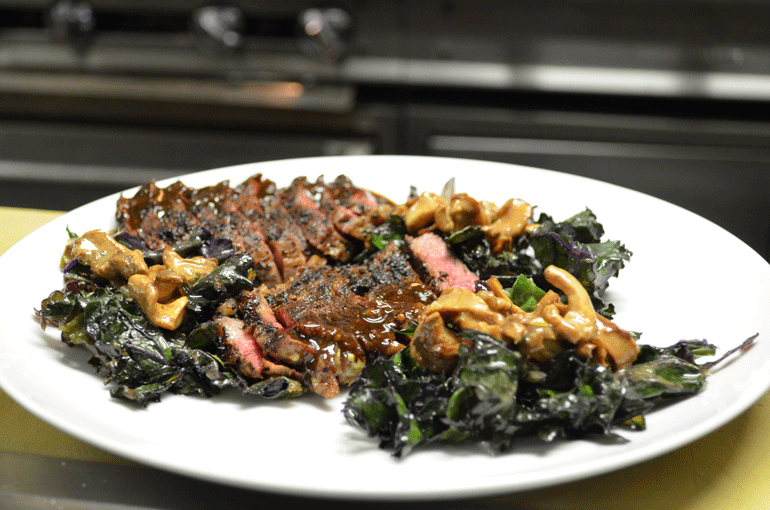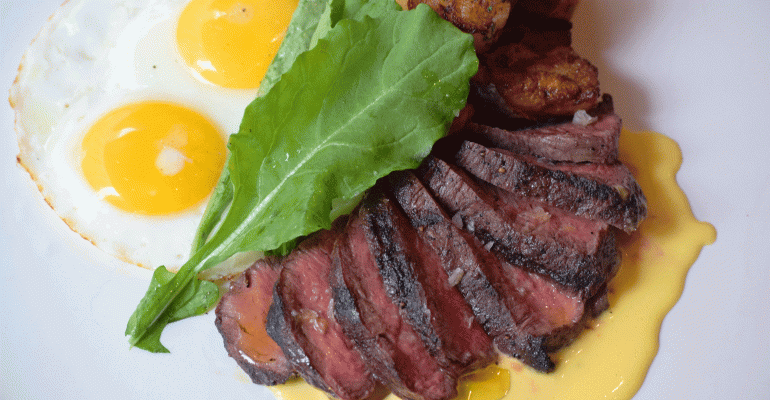Plant-based meals and faux-meat burgers have been taking up more space on menus of late, but some chefs are bringing back the beef with newer cuts of meat.
When it comes to beef, some operators are interested in focusing on underutilized cuts, as well as upgrading meat quality and versatility across the menu, according to Datassential’s January 2018 Meat and Poultry Keynote.
“There’s some cachet to a new cut, especially for trendier, younger consumers who are willing to try something new,” said Jackie Rodriguez, senior project manager at Datassential. “It adds a fresh note.”
The fastest-growing cut of meat on menus is bavette steak, with 167-percent growth over the last four years, according to Datassential. Bavette steak is cut from the bottom sirloin and is known for being lean yet flavorful, especially when cooked quickly.

Grilled Denver steak with kale and confit shallots and a bordelaise sauce reduction was recently on the menu at Michael’s Santa Monica.
At Reynard in the Wythe Hotel, in Brooklyn, N.Y., chef Christina Lecki serves bavette steak with broccoli di cicco (an heirloom variety of broccoli), raclette cheese sauce and green peppercorn.
“The bavette cut is a very tender cut of meat,” Lecki said. “It’s super flavorful, incredibly versatile and an approachable cut, which appeals to our guests. It has a grain structure similar to hanger steak that our guests seem to respond really well to.”
Lecki and her staff butcher whole animals in-house so fresh cuts can be added to the menu as the animal is broken down.
“We want to expose our guests to different textures and flavor profiles of the animal, and so we’re always excited to share a lesser-known cut on our menu,” she said.
Another cut showing up on more menus is the coulotte, also known as the sirloin cap, which is known for its rich taste and texture.
At Red Star Tavern in Portland, Ore., chef Dolan Lane regularly menus coulotte steak. Lane most recently served this cut for breakfast and brunch, with two eggs cooked any way, hollandaise sauce, arugula and toast.
“I like the cut because when cooked properly and rested, it brings a lot of flavor and has texture to it, without being tough or too chewy,” Lane said. “It’s also often more tender than the top sirloin steak it is connected to.”
Also known in Brazilian cuisine as the picanha, the coulotte is the signature steak at the Brazilian chain Fogo de Chão.
Another cut chefs seem to be loving is Denver steak, a cut from the chuck under-blade that is often braised or slow-cooked, similar to short ribs.
Chef Miles Thompson has been offering Denver steak in various preparations at Michael’s Santa Monica in Santa Monica, Calif. Currently, he is simply seasoning the steak and cooking it in a pan. He serves it with yuzu hollandaise, sautéed spigarello (an heirloom varietal of broccoli rabe) and Worcestershire sauce. Previously, he salted the cut, then rolled it in Japanese mayonnaise before grilling it and serving it with kale, confit shallots and a Bordelaise sauce reduction.
Heather Thomason, owner of Primal Supply Meats, a Philadelphia-based butchery and local sourcing company, said she’s seeing more interest in new cuts from the chefs she serves.
“They want to be on the edge a little bit,” Thomason said. “[They] like it because it lets them be creative.”
There’s also been buzz about oyster (or spider) steak, which is a delicate cut from right inside the hip on either side of the cow. But with only two available from a single animal, Thomason said it’s not likely to take off on menus.
But do other less common cuts have a long-term future on menus?
“We’ve been selling these cuts, educating customers,” Thomason said. “It's a slow game to educate the eater so they know what to expect.”





